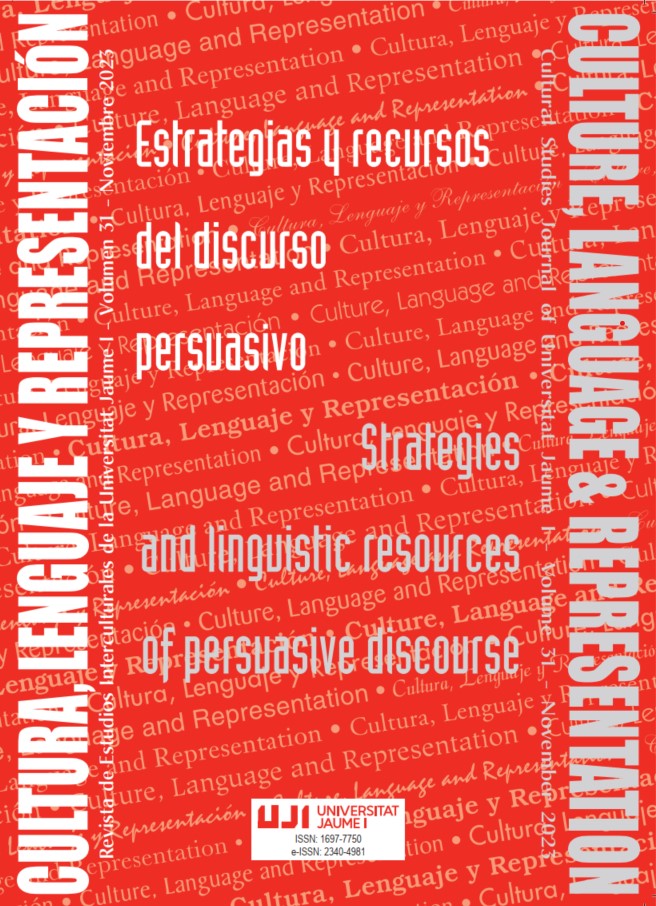Methodological application to the study of the use of argumentative connectors as an indicator of pragmatic competence in learners and native speakers of Spanish
Main Article Content
Abstract
Pragmatic competence involves the comprehension and production of communicative action in discourse. Achieving advanced pragmatic and discourse competence in an L2 implies having at one's disposal a set of skills that enable the speaker to produce and understand communicative action in discourse. One of these skills concerns the appropriate use of discourse markers, and more precisely, argumentative connectors, as they are tools for argumentative activity, an inherent dimension in human communication. Previous research on the subject has shown that learners tend to use fewer and less diverse argumentative connectors than native speakers. This could be mainly due to the polyfunctional nature of discourse markers and the complicated syntactic structures in which they are embedded, which can be challenging for an inexperienced speaker.
Thus, in this article, we examine pragmatic competence in Dutch-speaking learners and native speakers of Spanish with a particular focus on their oral use of argumentative connectors, in order to determine whether and in what respects this use differs or overlaps in the two groups. To this end, we use a contrastive methodology, both qualitative as well as quantitative, which pays specific attention to the polyfunctionality of the connectors pues, entonces, así and pero. The goal of the study is to determine how this polyfunctionality is reflected in the oral discourse produced by the learner group.
Downloads
Article Details
An open-access CREATIVE COMMONS copyright license is used. Those authors whose works are published by this journal, accept the following terms:
- Authors will retain their copyright and guarantee the Journal the right to first publish their work, which will simultaneously be subject to the Creative Commons Recognition License CC BY SA that allows third parties to share the work, provided that its author and first publication is indicated.
- Authors may adopt other non-exclusive license agreements for the distribution of the published version of the work (e.g., deposit it in an institutional telematics file or publish it in a monographic volume) provided that the initial publication in this journal is indicated.
- Authors are allowed and recommended to disseminate their work over the Internet (e.g. in institutional telematics files or on their website) before and during the submission process, which can produce interesting exchanges and increase quotes of the published work.
References
Briz, Antonio. 1993. «Los conectores pragmáticos en español coloquial (I): su papel argumentativo». Contextos, 21-22: 145-188.
Bustos Gisbert, José Manuel. 2015. «Conexión discursiva en aprendices anglohablantes de ELE». Revista Española de Lingüística, 45(2): 7-40.
Crible, Ludivine y Pascual, Elena. 2019. «Combinations of discourse markers with repairs and repetitions in English, French and Spanish». Journal of Pragmatics, 156: 54-67
Domínguez García, Noemí María. 2007. Conectores discursivos en textos argumentativos breves. Madrid: Arco Libros.
Ducrot, Oswald. 1980. «Analyses pragmatiques». Communications, 32: 11-60.
Félix-Brasdefer, J. César y DiBartolomeo, Megan. 2021. «Developing advanced pragmatic competence in Spanish». En Advancedness in Second Language Spanish. Definitions, challenges and possibilities, ed. Mandy R. Menke y Paul A. Malovhr. Amsterdam: John Benjamins.
Fernández Silva, Claudia. 2011. «El uso de los conectores contraargumentativos. Un estudio comparativo de monografías escritas por hablantes nativos y no nativos de español». En Del texto a la lengua: la aplicación de los textos a la enseñanza-aprendizaje del español L2-LE, ed. Jorge Juan Sánchez Iglesias, Javier de Santiago-Guervós, Marta Seseña Gómez y Hanne Bongaerts. Salamanca: Imprenta Kadmos, pp. 323-334.
Fernández, Julieta, Gates Tapia, Anna y Lu, Xiaofei. 2014. «Oral proficiency and pragmatic marker use in L2 spoken Spanish: the case of pues and bueno». Journal of Pragmatics, 74: 150-164.
Fuentes Rodríguez, Catalina. 2009. Diccionario de conectores y operadores del español. Madrid: Arco Libros.
Garcés Gómez, María Pilar. 2008. La organización del discurso: marcadores de ordenación y de reformulación. Madrid: Iberoamericana, Frankfurt am Main: Vervuert.
Haselow, Alexander. 2021. «The acquisition of pragmatic markers in the foreign language classroom: An experimental study on the effects of implicit and explicit learning». Journal of Pragmatics, 186: 73-86.
Heredero Zorzo, David. 2016. «Diferencias significativas en el uso de marcadores discursivos entre hablantes nativos de español y aprendientes eslovenos de ELE». Revista Nebrija de Lingüística Aplicada a la Enseñanza de Lenguas, 10(21): 76-85.
Instituto Cervantes. 2007. Plan Curricular del Instituto Cervantes. Niveles de referencia para el español. Madrid: Edelsa.
Llopis Cardona, Ana. 2014. Aproximación funcional a los marcadores discursivos: análisis y aplicación lexicográfica. Frankfurt am Main: Peter Lang Edition.
Martí Sánchez, Manuel. 2008. Los marcadores en español L/E: conectores discursivos y operadores pragmáticos. Madrid: Arco Libros.
Martí Sánchez, Manuel. 2013. Los marcadores discursivos. Madrid: Editorial Edinumen.
Mosegaard Hansen, Maj-Britt. 1998. «The semantic status of discourse markers». Lingua, 104: 235-260.
Pardo Llibrer, Adrià. 2019. «La enseñanza de marcadores en el aula de E/LE desde la segmentacion discursiva: el caso de pues». Foro de profesores de E/LE, 20: 179-190. DOI: 10.7203/foroele.0.14865
Pihler Ciglič, Barbara, Vande Casteele, An (2021). «Un estudio contrastivo del empleo de los marcadores discursivos por estudiantes universitarios de ELE». En Sintaxis discursiva: construcciones y operadores discursivos, ed. Catalina Fuentes Rodríguez, Ester Brenes Peña, Ester. Bern (etc.): Peter Lang, pp. 347-370. Linguistic insights, Studies in language and communication, 284.
Portolés Lázaro, José. 1993. «La distinción entre los conectores y otros marcadores del discurso en español». Verba. Anuario Galego de Filoloxía, 20: 141-170.
Portolés Lázaro, José. 2007. Los marcadores del discurso. Barcelona: Editorial Ariel.
Sperber, Dan y Wilson, Deirdre. 1986. Relevance. Oxford: Basil Blackwell.
Uribe Mallarino, Maria Rosario. 2005. «Conectores y contrastividad: el caso de pues». AISPI. Actas XXIII: 563-578.
Z


